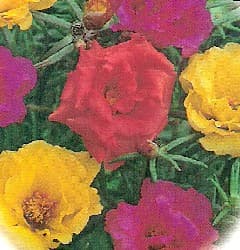How to Grow Portulaca Flowers

Growing Portulaca Flower Plants in Your Home Garden
Low growing Portulaca flowers are a ground cover that is sure to please. Native to Brazil, Argentina, and Uruguay, it should be no surprise to discover, that annual Portulaca plants are drought and heat tolerant.
Portulaca is an easy-to-grow annual plant. Flower colors include shades of rose, yellow, white, orange, red, purple, and pink. Flowers will bloom in early summer.
Portulaca flowers attract butterflies.
Try growing Portulaca plants as a ground cover, along walkways, around the house or garage, in rock gardens, and on hillsides. The plants spread easily. And, growing Portulaca flowers is easy.
Other Names include Sun Rose or Sun Plant
Did you Know? Portulaca seeds are edible raw or cooked. Seed can be ground up and put into recipes, soups, and sauces.
Plant Height: 3-6 inches
Annual Portulaca Grandiflora
Now here is an old garden gem. Foxglove has spikes of distinctive, freckle-throated bells that stud the flower stems. They provide a graceful, stately look in a partly shady garden. They are at home in the woodland or native garden and look well in the back of the home garden. If you’ve never tried grown Foxglove before, There’s no better time to start than this season. Use this guide to learn “How to Grow Foxglove Flowers”. Then, get growing Foxglove flowers.
Foxglove blooms during early summer in various shades of shell pink, rose, cream, and white, with contrasting freckles. They are natives of Europe, Western Asia, and Northern Africa.
FLowers Bloom: Min-summer
Flower Colors:
Caution: The leaves are poisonous. If you have children or pets, you might want to steer clear of this flower. The poisonous substance in the leaves is called Digitalis. You may recognize this as a chemical sometimes used in the treatment of heart disease.
Biennial or Perennials, Digitalis
Portulaca Plant Propagation
Grow Portulaca plants from seed. These annuals are prolific re-seeders. Make sure to plant them where they can reseed and grow, year after year.
When planting seeds, it is not necessary to cover them. They require light to germinate.
For indoor starts, sow seeds 6 weeks before the last frost in your area.
For indoor starts, we recommend using a seedling germination mat.
Do not set out seedlings until after the last frost date in your area. Plants are susceptible to frost. The ideal plant spacing is ten inches apart.
Established plants can also be propagated by cuttings.
Days to Germination: 14 to 21 days.
How to Grow Portulaca Flower Plants
Annal Portulaca plants are easy to grow. Grow plants in full sun.
The plants prefer loose, sandy, or loam soil. A well-draining composition is important.
Portulaca plants are drought and heat tolerant.
Water only during droughts. The plants retain water. If growing in containers or hanging pots, allow the soil to dry between watering.
Feed the plants a general-purpose, high nitrogen fertilizer when first planting, to help them to get a good start. Add a high Phosphorous fertilizer just before blooming. No other fertilizer applications should be needed for the season.
Portulaca produces long lasting, rose-like blooms in early summer. Pinch or deadhead spent flowers, to promote more blooms.
Prune plants to create a fuller, neater appearance. Provide plenty of air circulation through the plant to help avoid fungal disease.
Plants are annuals that are very susceptible to frost. Cover them up whenever cold temperatures are expected.
Ideal Soil pH: 5.5 – 7.0.
Insects and Plant Disease
Aphids, gnats, and other insects can pose a problem. Treat with insecticide or repellents, as needed. Snails and slugs can also be a problem. See more on Snail and Slug Control.
Fungus diseases can occur. Use a general-purpose fungicide in humid weather, and when problems appear. Stem and root rot can occur. This is a problem in wet soil. Avoid problems by planting in sandy, or other well-draining soil. A slightly elevated planting bed also helps to avoid this problem.
Related Articles
Also, people who read this article will like:
Plant Problems – Identify the causes and find the cures.
Please support our site. Shop for:
- rmmatthews100@hotmail.com
- 585-721-6528
- Rochester, NY
©1999-2024 GardenersNet.Com, All Rights Reserved

